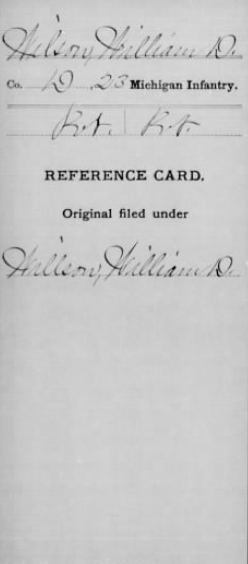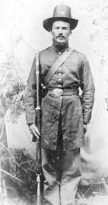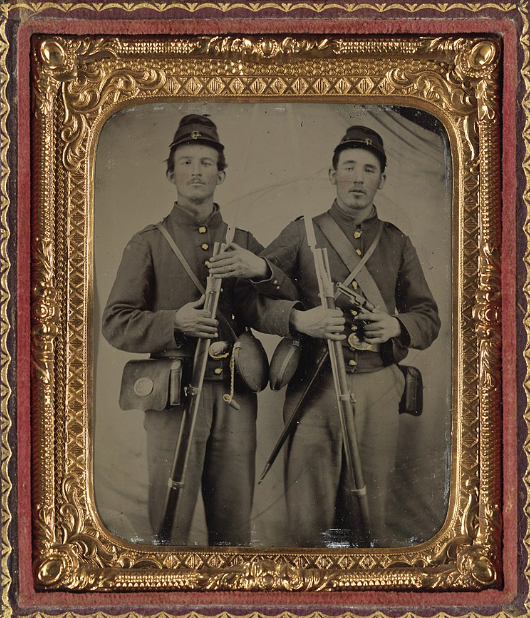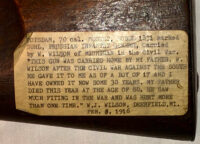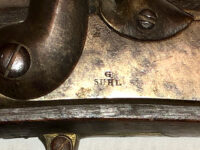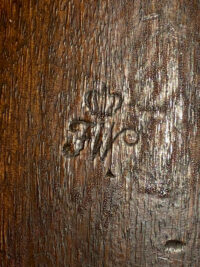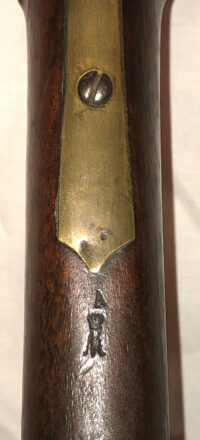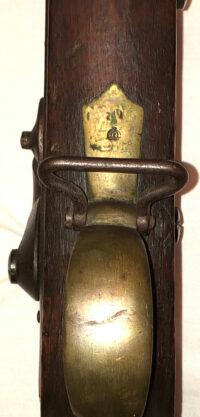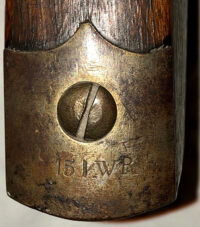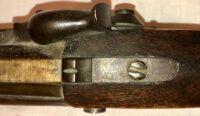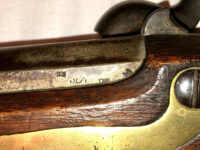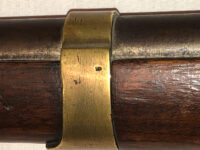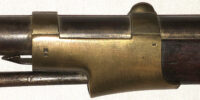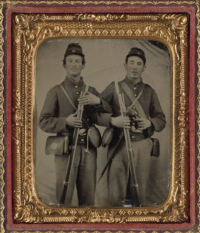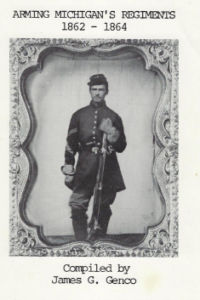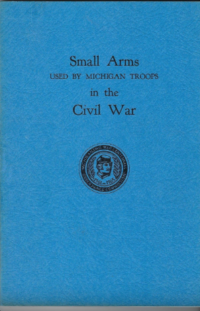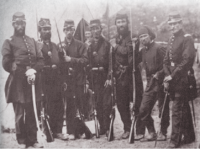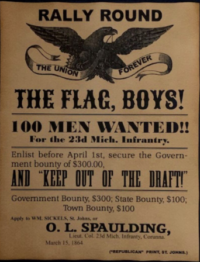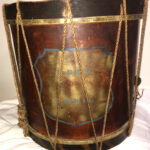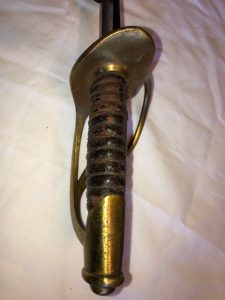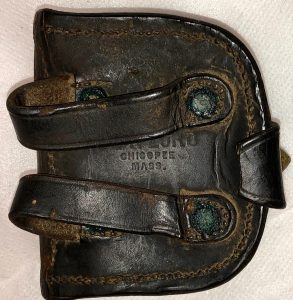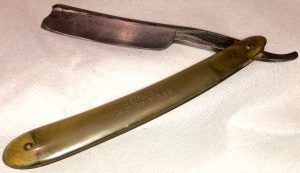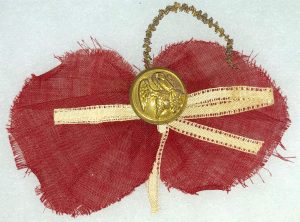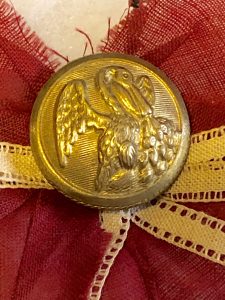Id’d Model 1809 / 1831 Prussian Potsdam Musket Carried by Private William Wilson Co. D 23rd Michigan Infantry
SOLD
Id’d Model 1809 / 1831 Prussian Potsdam Musket Carried by Private William Wilson Co. D 23rd Michigan Infantry – This percussion, Prussian, Potsdam Model 1809 Musket, was likely converted from flintlock to percussion c. 1832, at the Prussian armory at Suhl – the lock plate is stamped “Suhl”. The Potsdam musket was the standard infantry weapon of the Royal Prussian Army from the 18th century until the military reforms of the 1840s. These firearms generally called “Potsdam” muskets, were named after the most common of the makers. Guns in this group were made at Prussian armories in Potsdam, Danzig, Neisse, Suhl and Saarn. Four models were produced at Potsdam, including the Model 1723, the Model 1740, the Model 1809 and the Model 1831. The Model 1809 was originally made with a flintlock firing mode; the Prussian government, after 1831, amended the model designation to the Model 1809/31 and converted the firing mode to the more updated and reliable percussion, firing system.
At the onset of the Civil War, both the Union and the Confederacy were desperate for small arms, as the South had little capability to make their own, and the North had to suddenly enhance arms production. Though the Potsdam muskets were considered obsolete by 1861, extant, period, government records indicate that the U.S. Ordnance Department purchased approximately 165,000 Prussian arms, of which 100,300 were identified as smoothbores. Although no known contracts are extant that definitively show the purchase of these guns by the Confederacy, some recent research does reference sales by a Liege, arms purveyor, of some 51,000 of these converted, M1809 muskets to the Confederacy, during the late Fall of 1861. Many of the older models, like this Potsdam musket, were not in use in Europe by the 1860’s and would have been sold to countries that were in desperate need of arms. All of the shipments of these muskets arrived in late 1861 through early 1862, when the need for arms was most urgent. Records also indicate that three Michigan units, the 21st, 22nd and 23rd Michigan Infantry Regiments, were recipients of these guns, which they referred to as “Austrian” muskets.
This example of a Potsdam musket, issued in America, retains an old, typed paper tag, glued to the left side of the butt stock, that reads as follows:
“Potsdam .70 cal. musket, Model 1831 marked
SUHL, PRUSSIAN INFANTRY GEWEHR, Carried by
- Wilson of MICHIGAN in the Civil War.
“THIS GUN WAS CARRIED HOME BY MY FATHER, W.
AFTER THE CIVIL WAR AGAINST THE SOUTH.
HE GAVE IT TO ME AS OF A BOY OF 17 AND I
HAVE OWNED IT NOW SOME 30 YEARS. MY FATHER
DIED THIS YEAR AT THE AGE OF 80. HE SAW
MUCH FITING (sic) IN THE WAR AND WAS HURT MORE
THAN ONE TIME.” W. J. WILSON, DEERFIELD, MI.
FEB. 3, 1916
William D. Wilson, born in Juniata, Michigan, in the late 1830s, enlisted in Co. D of the 23rd Michigan Infantry, in August, 1862. He would serve in this regiment until the end of the war, mustering out in June, 1865. During the majority of Wilson’s tenure in the 23rd, the regiment would be attached to the Army of Ohio, ending their service in the Department of North Carolina. During the war, the 23rd Michigan saw action at: Knoxville, Resaca, Kennesaw Mountain, Atlanta, Jonesboro, Franklin, Nashville and the Carolinas’ Campaign. After the war, Private Wilson would return to Michigan, where his son, William J. Wilson, was born, in 1869. Private Wilson died, as indicated on the note attached to this gun’s stock, in 1916.
The musket remains in overall fine condition; the iron elements are nicely browned, the original, trumpet-shaped ramrod is in place, and the brass parts exhibit a pleasing, mustard-yellow, patinated surface. The firing mechanism is in excellent condition, as well. The small latch like device, at the distal end of the large, end barrel band, an unusual mode of attachment of the rare, socket bayonet, remains in place. During the process of conversion to percussion, a very heavy bolster and hammer, exhibited on this gun, were installed. Although the original brass butt plate was frequently replaced with an iron one, this musket retains its original brass version, as well as its original brass trigger guard, side plate and barrel bands. The Model 1809’s lock plate has a curved tail that ends in a small teat-like projection, as seen on this example; this characteristic differentiates this gun from the later 1839 model which did not have this lock plate projection. The finials on the trigger guard and the toe of the butt plate end in a three-pointed configuration. The musket shows the characteristic sunken cheek rest and the tall block sight on the breech plug. Besides the Suhl marking on the gun’s lock plate, there are numerous, Prussian, government markings on the gun and stock – stamped on the stock in, at least, a couple of places is a crown over “FW” – this stands for Friedrich Wilhelm III (1770-1840); the brass barrel bands and side plate are all stamped with a matching number “5”; stamped on the tang of the butt plate is “15LWR” – probably indicative of original use by the 15th Landwehr Regiment. The gun’s stock, possibly light-colored beechwood, remains in excellent condition; there is some darkened, burnout area behind the nipple bolster, indicative of actual use, by Private Wilson, during the Civil War. Potsdam muskets are found with some regularity today, but this is the first Id’d one we have had.
Barrel Length – 41”
Caliber – .72 (smoothbore)
William D. Wilson
| Residence Juniata MI; 33 years old. – Juniata is a town in Tuscola, MI
Enlisted on 8/11/1862 at Vassar, MI as a Private. On 9/12/1862 he mustered into “D” Co. MI 23rd Infantry He was Mustered Out on 6/28/1865 at Salisbury, NC Other Information: Buried: Fairgrove, MI
|
23rd MI Infantry
( 3-years )
| Organized: East Saginaw, MI on 9/13/62 Mustered Out: 6/28/65 at Salisbury, NCOfficers Killed or Mortally Wounded: 3 Officers Died of Disease, Accidents, etc.: 4 Enlisted Men Killed or Mortally Wounded: 70 Enlisted Men Died of Disease, Accidents, etc.: 257 (Source: Fox, Regimental Losses) |
| From | To | Brigade | Division | Corps | Army | Comment |
| Sep ’62 | Nov ’62 | 38 | 12 | Army of Ohio | ||
| Dec ’62 | Jun ’63 | 34 | District of Western KY | Army of Kentucky | Army and Dept of Ohio | |
| Jun ’63 | Aug ’63 | 1 | 3 | 23 | Army and Dept of Ohio | |
| Aug ’63 | Feb ’65 | 2 | 2 | 23 | Army and Dept of Ohio | |
| Feb ’65 | Jun ’65 | 2 | 2 | 23 | Department of North Carolina | Mustered Out |
MICHIGAN
Twenty-Third Infantry.
(Three Years)
| The Twenty-third was recruited in the Sixth congressional
district, and was rendezvoused at Saginaw. It was mustered into service Sept. 13, 1862, with an enrollment of 983 officers and men. The field, staff and line officers at organization were as follows: Colonel, Marshall W. Chapin, Detroit. Lieutenant Colonel, Gilbert E. Pratt, Detroit. Major, Benjamin F. Fisher, East Saginaw. Surgeon, Louis W. Fasquelle, St. Johns. Assistant Surgeon, Gilbert H. Blaker, Houghton. Second Assistant Surgeon, Gilbert Bogart, Jr., Flint. Adjutant, Campbell Montgomery, Detroit. Quartermaster, Charles D. Little, Saginaw City. Chaplain, James S. Smart, Flint.
A. Captain, Oliver L. Spaulding, St. Johns. First Lieutenant, William Sickles, St. Johns. Second Lieutenant, James Travis, St. Johns.
B. Captain, Henry Woodruff, East Saginaw. First Lieutenant, Fayette Smith, Bridgeport. Second Lieutenant, William A. Lewis, East Saginaw.
C. Captain, Charles E. McAllister, Flint. First Lieutenant, George W. Buckingham, Flint. Second Lieutenant, William C. Stewart, Flint.
D. Captain, Benjamin W. Huston, Vassar. First Lieutenant, John Hamilton, Watrousville. Second Lieutenant, John G. Riggs, Millington.
E. Captain, Henry C. Norville, Saginaw City. First Lieutenant, John Earl, Harrisville. Second Lieutenant, Lester E. Cross, Saginaw City.
F. Captain, Henry S. Raymond, Bay City. First Lieutenant, Eben R. Ayers, Port Austin. Second Lieutenant, John S. McKinney, Portsmouth.
G. Captain, Henry Walbridge, St. Johns. First Lieutenant, Stephen J. Wright, St. Johns. Second Lieutenant, Alonzo O. Hunt, St. Johns.
H. Captain, John Carland, Caledonia. First Lieutenant, Benjamin F. Briscoe, Caledonia. Second Lieutenant, Marvin Miller, Corunna.
I. Captain, Carlos D. Sheldon, Houghton. First Lieutenant, Graham Pope, Houghton. Second Lieutenant, William H. Patterson, Houghton.
K. Captain, Damon Stewart, Flint. First Lieutenant, Samuel C. Randall, Flint. Second Lieutenant, John Rea, Flint.
The regiment left Saginaw the 18th of September, and proceeded to Kentucky, where it was assigned to the army commanded by General Rosecrans. The Twenty-third was at Bowling Green, Ky., also at Carthage, Glasgow and Thompkinsville during the winter, and in July, 1863, started on a long march after the confederate General John Morgan, and during this campaign was at Louisville, Ky., Jeffersonville, Ind., Cincinnati, Portsmouth and Chillicothe, Ohio, and then returned to Paris, Ky. It was assigned to the Second Brigade, Second Division, Twentieth Corps Army of the Ohio, and started, in August, on the East Tennessee campaign, and arrived at Knoxville Sept. 15. After a march through East Tennessee, the regiment returned to Knoxville, and was stationed at Loudon to intercept General Longstreet’s advance. It came in contact with the confederates, who were marching upon Knoxville, and heavy skirmishing commenced at once. The enemy attacked vigorously, and the Union lines were slowly driven back, making an obstinate defense of every foot of ground yielded. At Campbell’s Station, a few miles west of Knoxville, a battle was fought with Longstreet’s forces, in which the Twenty-third lost heavily in killed and wounded. The weather was cold and rainy, the roads almost impassable on account of deep mud, and the troops were but poorly supplied with rations, and great suffering was caused by a lack of tents, clothing, boots and shoes. The Twenty-third acted as rear guard while the corps was retiring upon Knoxville, and received special commendation for its efficient work under the most trying circumstances. The regiment was actively engaged in the defense of Knoxville, and when General Longstreet swept around the city and marched into East Tennessee, the Twenty-third was one of the regiments that followed him, but when General Grant decided to allow the confederates to remain in Tennessee during the winter, the Twenty-third returned to Knoxville, almost destitute of equipments in the way of tents, blankets and clothing. The regiment shared the hardships of the East Tennessee campaign until May, 1864, when it started upon the Atlanta campaign with the army commanded by General Sherman. After an encounter with the enemy at Rocky Face Ridge, it moved through Snake Creek Gap and made a desperate assault upon the enemy’s works at Resaca, Ga., meeting with a loss of sixty killed and wounded in a few minutes. The Twenty-third took part in the various movements of the Twenty-third Corps, frequently coming in contact with the enemy at Lost Mountain, Kenesaw Mountain, Chattahoochee River and Siege of Atlanta. After the fall of Atlanta the Twenty-third was sent in pursuit of the confederate General Hood, who marched his army through Georgia and Alabama to Nashville, Tenn. During this march it retraced its steps over a portion of the ground it had occupied on the march to Atlanta. It reached Columbia on the 25th of November, where it joined the Union forces to oppose the further advance of General Hood. At Duck River the regiment skirmished heavily with the enemy, and fell back to Franklin, where a desperate battle was fought, the confederates charging upon the works hastily thrown up, and were repelled by a hand-to-hand conflict. The obstinate resistance offered by the Union forces delayed the march of General Hood so General Thomas, at Nashville, could organize his troops for the final struggle before that city. Probably there was no more desperate fighting in any battle of the war than at Franklin, Tenn., and the Twenty-third was in the line when the fighting was fiercest. The Union forces fell back to Nashville, and on Dec. 15 and 16 the Twenty-third, with the army under General Thomas, in a two days’ battle, completely defeating the confederates under General Hood, and drove them back in utter rout to Duck River. During the battle the Twenty-third charged the enemy, securely placed behind a stone wall on the crest of a hill, demoralizing the confederates and taking more prisoners than there were men in the Twenty-third. The crushing of General Hood by General Thomas relieved the western department from immediate attack by the enemy, and the Twenty-third Corps was ordered to Washington, D. C., to co- operate with General Sherman’s army, then marching north through the Carolinas. The Twenty-third, with its corps, was embarked at Alexandria, Va., on transports, and proceeded to the mouth of Cape Fear River. At Smithville, S. C., the regiment was disembarked, and particpated in the attack upon Fort Anderson, carrying the works in gallant style, the Twenty- third being the first regiment to enter the fort. The regiment marched to Wilmington, N. C., and upon the evacuation of that place by the confederates, the Twenty-third proceeded to Kingston, and then to Goldsboro, where it arrived March 22, making a junction with General Sherman’s army, which arrived the next day. The Twenty-third marched to Raleigh, N. C., and then started for Greensboro, N. C., ninety miles distant, where General Johnson surrendered his army to General Sherman. The Twenty-third was at Salisbury, N. C., June 28, at which date it was mustered out of service, and returned to Detroit, Mich., where it was paid off and disbanded July 20, 1865 The regiment during service had met the enemy at Paris, Ky., July 29, 1863; Huff’s Ferry, Tenn., Nov. 12, 1863; Campbell’s Station, Tenn., Nov. 16, 1863; siege of Knoxville, Tenn., Nov. 17, to Dec. 5, 1863; Dandridge, Tenn., Jan. 14, 1864; Strawberry Plains, Tenn., Jan. 22, 1864; Rocky Face, Ga., May 8, 1864; Resaca, Ga., May 14, 1864; Etowah River, Ga., May 22, 1864; Dallas, Ga., May 27, 1864; New Hope Church, Ga., June 1, 1864; Lost Mountain, Ga., June 17, 1864; Kenesaw Ga., June 27 1864; Chattahoochee River, Ga., July 5 and 6, 1864; siege of Atlanta, Ga., July 22 to Aug. 25, 1864; Lovejoy’s Station, Ga., Aug. 31, 1864; Columbia, Tenn., Nov. 25, 1864; Duck River, Tenn., Nov 28, 1864; Spring Hill, Tenn., Nov. 29, 1864; Franklin, Nov. 30, 1864; Nashville, Tenn., Dec. 12 to 16, 1864; Fort Anderson, N. C., Feb. 18, 1865; Town Creek, N. C., Feb. 20, 1865; Wilmington, N. C., Feb. 21, 1865; Goldsboro, N. C., March 22, 1865. Total enrollment……………………………..1477 Killed in action……………………………….38 Died of wounds…………………………………21 Died in Confederate prisons……………………..15 Died of disease……………………………….214 Discharged for disability (wounds and disease)……150 Source: Record of Service of Michigan Volunteers 1861-65
********************************************************************************
Report of Maj. William W. Wheeler, Twenty-third Michigan Infantry.
HDQRS. TWENTY-THIRD MICHIGAN INFANTRY, Knoxville, Tenn., November 30, 1863. SIR: I have the honor to report that while the Twenty-third Michigan Infantry Volunteers (a part of the Second Brigade, Second Division, Twenty-third Army Corps, Army of the Ohio) was in camp opposite Loudon, Tennessee (after the evacuation of that place by our forces on the 28th October, ultimo), by order of Brig. Gen. Julius White, commanding said Second Division, I was directed, near midnight of the 13th and 14th instant, to proceed with the Twenty-third Michigan Volunteers and one section of Henshaw’s (independent Illinois) battery toward Huff’s Ferry (which is opposite the lower fortification at Loudon) for the purpose of verifying the information received of the passage of a portion of the enemy’s forces on a pontoon bridge thrown across the river at that point. About 2 o’clock on the morning of the 14th instant, I arrived with the forces above mentioned at a point distant about 1 mile from Huff’s Ferry, having marched about 5 miles on the route, when I received an order from Brig.-Gen. White addressed to me, ordering me to return immediately to camp with the forces under my command. On reaching camp, in compliance with this order, I received instructions from your headquarters to send all baggage and transportation of the Twenty-third Michigan Volunteers to the rear toward Lenoir’s and to march my regiment as escort of the division and brigade trains.
As directed, the Twenty-third Michigan Volunteers marched to Lenoir’s, a distance of nearly 5 miles. At 12 m. of that day (Saturday, the 14th instant) I received orders from you to march my regiment (the Twenty-third Michigan Volunteers) toward Loudon, in rear of the other troops forming the Second Brigade aforesaid.
Passing the site of our camp left that morning, the Twenty-third Michigan, with the brigade column, had reached a point distant about 2 miles from Huff’s Ferry, when I received an order from Brig.-Gen. White to march the regiment in support of Capt. Sims’ (Twenty-fourth Indiana) battery, with which I proceeded in advance about half a mile, taking a position there assigned, and remained there during the night. Two sections of Henshaw’s (independent Illinois) battery in the meanwhile came up and took position at the same point. At 5 a.m. Sunday, the 15th instant, I received orders from Gen. White to proceed to the rear as rapidly as possible with the two batteries above mentioned.
For more than twenty-four hours the rain had fallen in torrents, and the roads, difficult at the best were almost impassable for carriages. I therefore distributed the men of my command along the traces attached to the carriages, and by dint of the most arduous toil succeeded in reaching Lenoir’s about 11 a.m., a distance of 9 miles. Here my command was again assigned to the support of the Twenty-fourth Indiana Battery, which was placed on a height commanding the river road from Loudon.
At 3 a.m., Monday, the 16th instant, I received an order from your headquarters to destroy my regimental wagons and to proceed toward Knoxville, in escort of Henshaw’s (Illinois) battery. The Twenty-third Michigan Volunteers Infantry arrived en route at Campbell’s Station, a distance of 9 miles, about 11 o’clock that morning. About noon the regiment was, by your direction, formed in line of battle behind a small branch (or creek) in a meadow to the left of the highway as one approaches Knoxville, and on the right of the Thirteenth Kentucky Infantry Volunteers Shortly after as the rear guard of the army came in, I was ordered by you to take up a new position about 200 yards toward the enemy, just in advance of a barn. A brigade of the Ninth Corps occupied the position between the right of my regiment and the woods which skirted the open fields to our right, and which were distant about 60 perches. I had previously thrown forward Capt. Buckingham’s company (A) as skirmishers, who had orders from you to retire without engaging the enemy.
About 1.30 p.m. the enemy advanced a line of skirmishers on our front. Capt. Buckingham’s company (A) retired in accordance with your instructions, leaving only the skirmishers of the Thirteenth Kentucky on the front of the right with of your brigade. At this juncture my regiment occupied the right center of our front, and was so placed that the right wing was on a slope looking toward the front and the woods before mentioned on our right, while the left wing occupied the crest and slope descending from our front. Directly afterward the skirmishers of the Thirteenth Kentucky Volunteers came in, leaving my regiment exposed to a galling fire from the enemy’s skirmishers on our front and on our right, which was replied to with considerable effect by Capt. Raymond’s company (F), which I had posted in the barn above mentioned. Having received orders from you to hold this position at all hazards, I remained there with my regiment about two hours, suffering a loss of 6 enlisted men killed, 1 officer slightly wounded, and of enlisted men 2 mortally, 13 seriously, and 9 slightly wounded. At the end of that time, perceiving the enemy making preparations to throw a light battery into position on our front, at a distance of about 700 yards (which I was unable to prevent), I sent an orderly to the rear to find you or some officer of your staff, in order that I might apprise you of the necessity of my forming a new line about 40 yards to the rear of my position, which could be sheltered by the crest of a ridge on the exposed of which the regiment was then posted. Presently Lieut. Montgomery, your acting assistant adjutant-general, came up. I explained the exigency to him, posted the markers and colors on the new line, and had just given orders for the new formation when the enemy opened his battery with a fire of spherical case, canister, and grape with great precision, but fortunately with little effect beyond dislodging Capt. Raymond’s company (F) from the barn already mentioned.
About half an hour after the formation of this new line I received orders from you through Capt. Gallup, brigade inspector on your staff, to march in retreat. This, therefore, I proceeded to do, unmasking our batteries, and exposed to the rear and severe fire of the enemy’s artillery crossing the highway leading toward Knoxville, and continuing beyond the range of the enemy’s batteries, with no further loss and without confusion or trepidation in the ranks of the regiment. We remained in this new position until nightfall, when the regiment took position in column of the brigade which formed the rear guard of the army, and about 7 p.m. proceeded toward Knoxville, which place we reached about 4 a.m., Tuesday, the 17th instant, having been under arms without rest four nights and three days with the slightest allowance of food, exposed to most inclement weather, and much of the time on fatiguing march in presence of the enemy.
On Tuesday morning, 17th instant, the regiment was assigned a position on Temperance Hill, Knoxville, and since that time has furnished heavy details for grand guard and fatigue parties, besides fortifying its own and adjacent front, but has not engaged the enemy.
Six enlisted men of this regiment, of a party left at Lenoir’s Station to destroy ammunition, are still missing, and are supposed to have been killed or taken prisoners by the enemy. The list of casualties, therefore, of the past month in our engagements with the enemy’s is as follows: Six enlisted men killed, 1 officer and 24 enlisted men wounded, and 6 enlisted men missing. Total killed, wounded, and missing, 37.
In conclusion, sir, I am gratified to add my testimony of the gallant conduct of the officers of the line and of the enlisted men of the Twenty-third Michigan Volunteers, and of the untiring zeal and efficiency of the regimental and medical staff, during the engagement at Campbell’s Station, which was the first in which it has been its fortune to take a part, and of the wonderful fortitude which has sustained them in all these trying circumstances without a murmur and without a doubt.
I have the honor to be, very respectfully, your obedient servant,
W. W. WHEELER, Maj., Comdg. Twenty-third Michigan Infantry Volunteers.
Col. M. W. CHAPIN, Comdg. Second Brig., Second Div., 23d Army Corps. |
23rd Michigan Infantry Regiment
| 23rd Michigan Infantry Regiment | |
| Michigan state flag | |
| Active | September 13, 1862, to June 28, 1865 |
| Country | United States |
| Allegiance | Union |
| Branch | Infantry |
| Engagements | Siege of Knoxville Battle of Resaca Battle of Kennesaw Mountain Battle of Atlanta Siege of Atlanta Battle of Jonesboro Battle of Franklin Battle of Nashville Campaign of the Carolinas |
The 23rd Michigan Infantry Regiment was an infantry regiment that served in the Union Army during the American Civil War.
Service
The 23rd Michigan Infantry was mustered into Federal service at East Saginaw, Michigan, on September 13, 1862.
The regiment was mustered out of service on June 28, 1865.
Total strength and casualties
The regiment suffered 3 officers and 70 enlisted men who were killed in action or mortally wounded and 4 officers and 257 enlisted men who died of disease, for a total of 334 fatalities.[1]
Commanders
- ColonelDavid Jerome, a future Governor of Michigan
- Colonel Oliver L. Spaulding
UNION MICHIGAN VOLUNTEERS
23rd Regiment, Michigan Infantry
OVERVIEW:
Organized at East Saginaw, Mich., and mustered in September 13, 1862. Left State for Louisville, Ky., September 18. Attached to 38th Brigade, 12th Division, Army of the Ohio, to November, 1862. District of Western Kentucky, Dept. of the Ohio, to June, 1863. 1st Brigade, 3rd Division, 23rd Army Corps, Army Ohio, to August, 1863. 2nd Brigade, 2ad Division, 23rd Army Corps, Army Ohio, to February, 1865, and Dept. of North Carolina, to June, 1865.
SERVICE:
Pursuit of Bragg’s forces from Louisville to Crab Orchard, Ky., October 1-16, 1862. Moved to Bowling Green October 16-19, and duty there till May 29, 1863. Moved to Glasgow, Ky., May 29-31, thence to Tompkinsville, Ky., and duty there till July. Pursuit of Morgan July 4-26. Action at Paris, Ky., July 29. Burnside’s Campaign in East Tennessee August 16-October 17. March into East Tennessee August 16-September 4. At Loudon till November. Knoxville Campaign November 4-December 23. Action at Ruff’s Ferry November 14. Near Loudon November 15. Campbell’s Station November 16. Siege of Knoxville November 17-December 5. Pursuit of Longstreet December 7-13. Duty at Strawberry Plains till January 14, 1864. Scott’s Mill Road near Knoxville January 27. Expedition to Flat Creek February 1. Duty at Mossy Creek till April 26. March to Charleston April 26-30. Atlanta (Ga.) Campaign May 1-September 8. Demonstrations on Dalton, Ga., May 9-13. Battle of Resaca May 14-15. Advance on Dallas May 18-25. Operations on line of Pumpkin Vine Creek and battles about Dallas, New Hope Church and Allatoona Hills May 25-June 5. Operations about Marietta and against Kenesaw Mountain June 10-July 2. Lost Mountain June 15-17. Muddy Creek June 17. Noyes Creek June 19. Kolb’s Farm June 22. Assault on Kenesaw June 27. Nickajack Creek July 2-5. Chattahoochie River July 5-17. Decatur July 19. Howard House July 20. Battle of Atlanta July 22. Siege of Atlanta July 22-August 25. Utoy Creek August 5-7. Flank movement on Jonesboro August 25-30. Battle of Jonesboro August 31-September 1. Lovejoy Station September 2-6. Pursuit of Hood into Alabama October 4-26. At Johnsonville till November 20. Nashville Campaign November-December. Battle of Franklin November 30. Battle of Nashville December 15-16. Pursuit of Hood to the Tennessee River December 17-28. At Clifton, Tenn., till January 16, 1865. Movement to Washington, D. C., thence to Fort Fisher, N. C., January 16-February 16. Capture of Wilmington February 22. Campaign of the Carolinas March 1-April 26. Advance on Goldsboro March 6-21. Occupation of Goldsboro March 21. Advance on Raleigh April 10-14. Occupation of Raleigh April 14. Bennett’s House April 26. Surrender of Johnston and his army. Duty at Raleigh, Greensboro and Salisbury to June. Mustered out June 28, 1865.
William J Wilson (son of Private William D. Wilson)
in the Michigan, U.S., Births and Christenings Index, 1867-1911
| Name | William J Wilson |
| Gender | Male |
| Birth Place | Tuscola, Michigan |
| Birth Date | 29 Aug 1869 |
| Baptism Place | Tuscola, Michigan |
| Father’s Name | William Wilson |
| Mother’s Name | Hellen A |



















